- More to Explore
- Series & Movies
Published May 18, 2021

Begin Program: The Reality Of Building a Holodeck Today
How close is current technology to creating fully immersive photonic playgrounds?
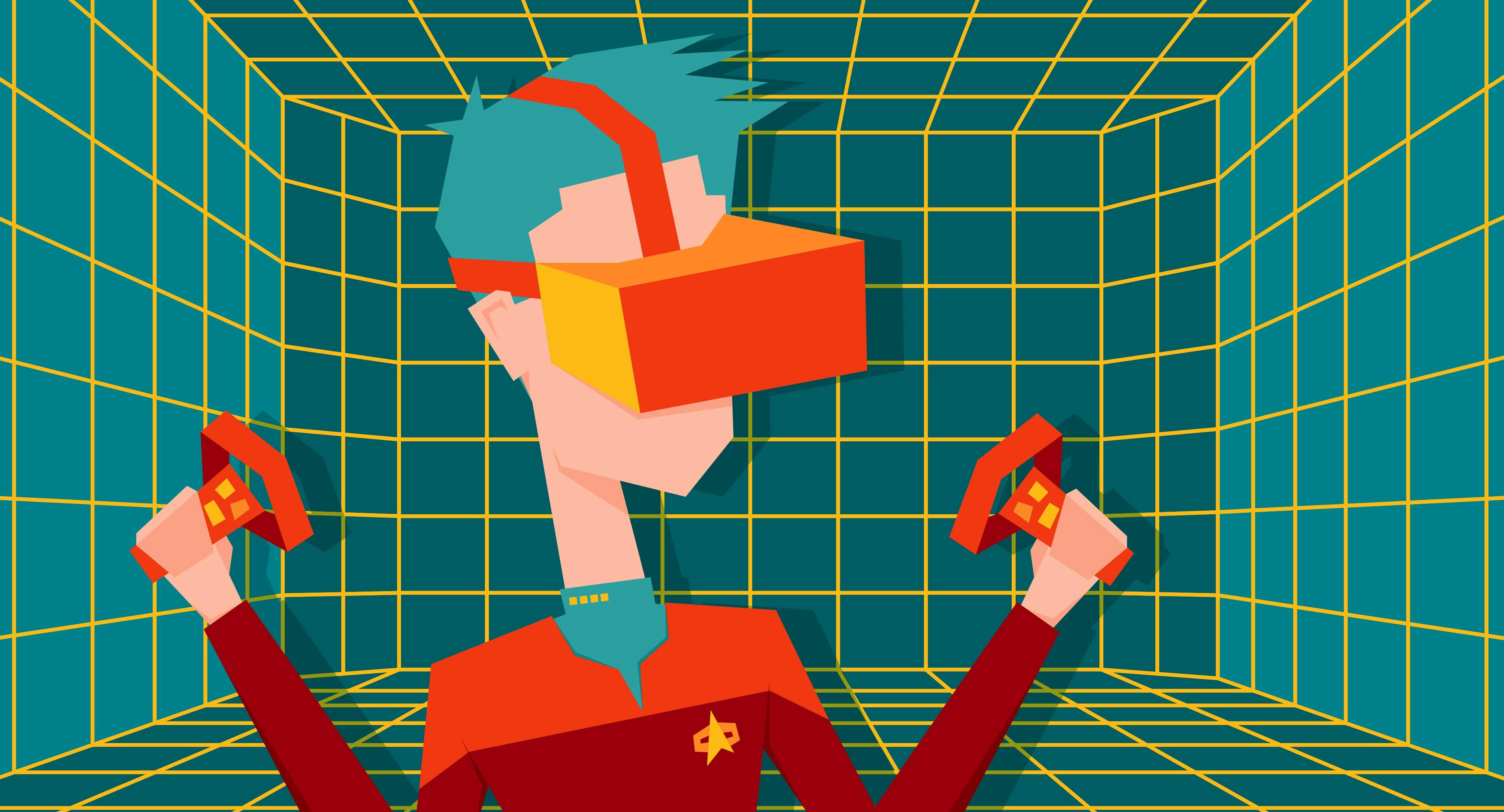
StarTrek.com
Since the moment we first saw Commander William T. Riker step out of an air-conditioned corridor on the U.S.S. Enterprise-D and into a lush green forest — still aboard the Enterprise — in “Encounter at Farpoint,” the holodeck has become a Starfleet fixture and a signature innovation of the Star Trek universe.
An early incarnation of the holodeck first appeared in an episode of Star Trek: The Animated Series in 1974 and was simply called a ‘recreation room.’ But it was The Next Generation that fully brought the storytelling possibilities of the 24th-century holodeck to life. It provides a space where crewmembers can run training scenarios, relax inside recreational ‘holonovels,’ and hang out with AI-powered approximations of their favorite historical figures.
Here in the 21st Century, the technology required to create interactive holographic projections still appears to be light-years away. But achieving holodeck-like experiences, capable of transporting out of our everyday world and into convincing alternate realities, are still possible.
The holodeck, from Gene Roddenberry’s original concept probably inspired by the work of Gene Dolgoff , works by blending transporter, replicator, and holography tech to create ‘solid’ photonic people and places out of ‘holomatter.’ The holodeck can also manipulate depth perception and spatial awareness to give people the sense of being in sprawling, fully-explorable environments, like the town of Sainte Claire in Voyager ’s “The Killing Game” — all without anyone running into the holodeck’s solid and immovable walls.
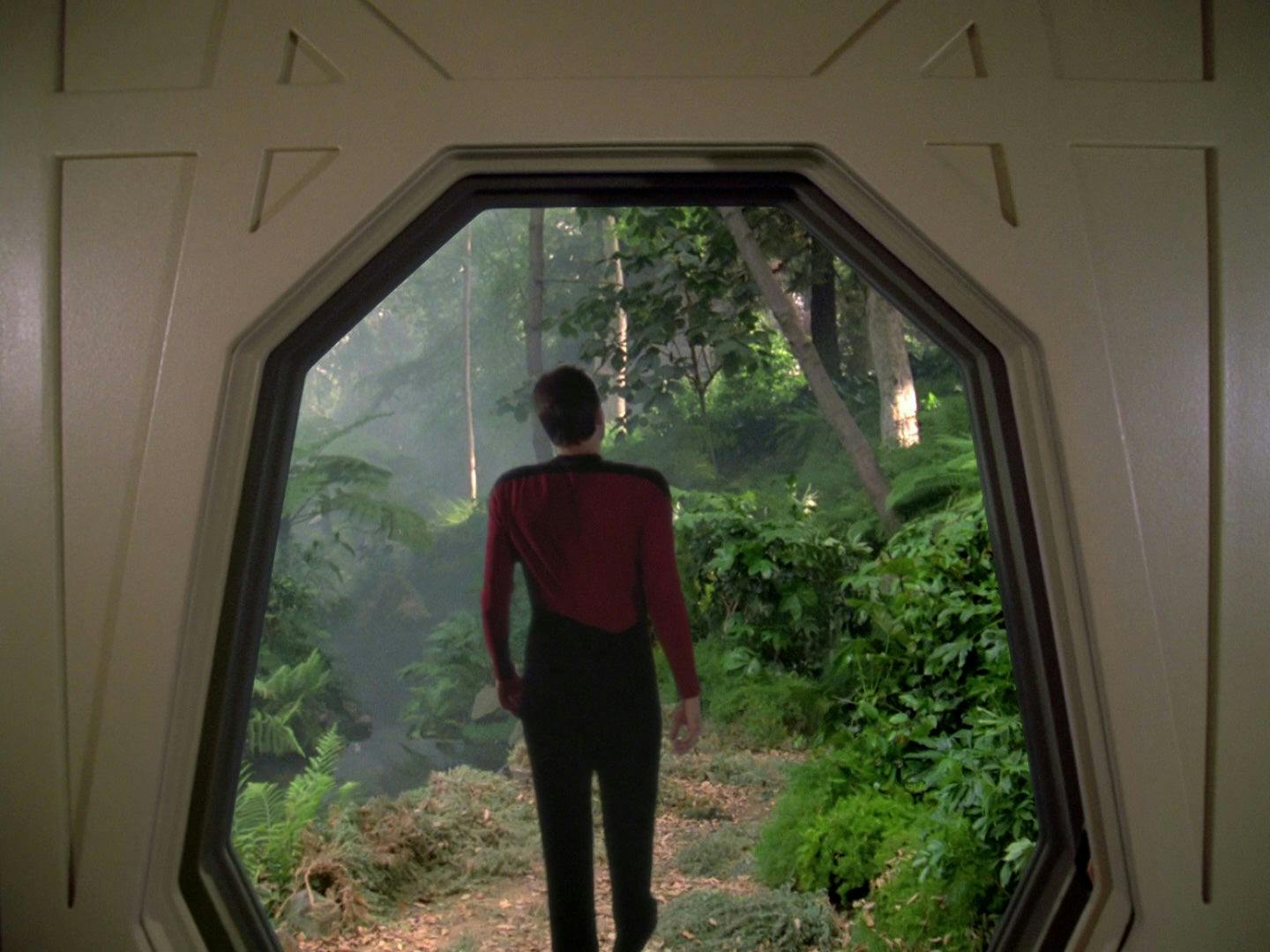
Since the holodeck first appeared, people have wondered what it would take to create one in real life. “The true holodeck of the future would need to be made of some kind of infinitely configurable organic matter,” says Verity McIntosh, Senior Lecturer in Virtual and Extended Realities at the University of the West of England.
Walking up a flight of stairs, McIntosh explains, would require the floor beneath you to rise up to create steps, organize itself into the rough texture of wood as you brush past a fence, and reconfigure itself to feel like fur as a cat passes by. “It could reconstitute itself in real-time to form the shapes, textures, and properties of the virtual world,” she says.
The tech used to construct the holodeck, though, isn’t simply highly advanced; it’s physically impossible. If you were to attempt to build your own, you would have to violate the laws of physics, which, to echo the feelings of many chiefs of engineering, is easier said than done. So until a Q pops by to leapfrog us into a new technological epoch, we can focus our energies instead on what’s readily achievable through virtual reality.
VR has already been shown to have many applications beyond entertainment. It can help with pain managemen t and support surgical training . Therapists have developed VR-based interventions to help with the treatment of PTSD , phobias , and managing stress . VR also gives us a meaningful way to connect with our friends, family and colleagues when we can’t see each other in person — which is why some believe it could come to define the future of working , learning , and socializing .
VR might also have an important role to play in our ongoing exploration of the cosmos. NASA has a Virtual Reality Lab where astronauts can prepare for spacewalks and train for delicate procedures, and VR has the potential to improve the wellbeing and mental health of astronauts embarking on longer missions as we travel further into space.
If VR is going to be our real-world answer to the holodeck, how does it measure up? Studies suggest that VR experiences are far more satisfying the more we feel immersed in them, which is why the goal of virtual reality developers — and what the holodeck perfectly nails — is greater immersion. Key to this is our sensation of presence, fooling our senses to believe that we are physically present within another space.
People who work in VR have spent years figuring out what it takes to achieve this, seeking out answers to questions like ‘how should light behave,’ ‘how wide does our field of vision need to be,’ and ‘how quickly do frames need to refresh to avoid motion sickness.’ But the biggest question is how do we bridge the gap between a virtual world and our five senses.
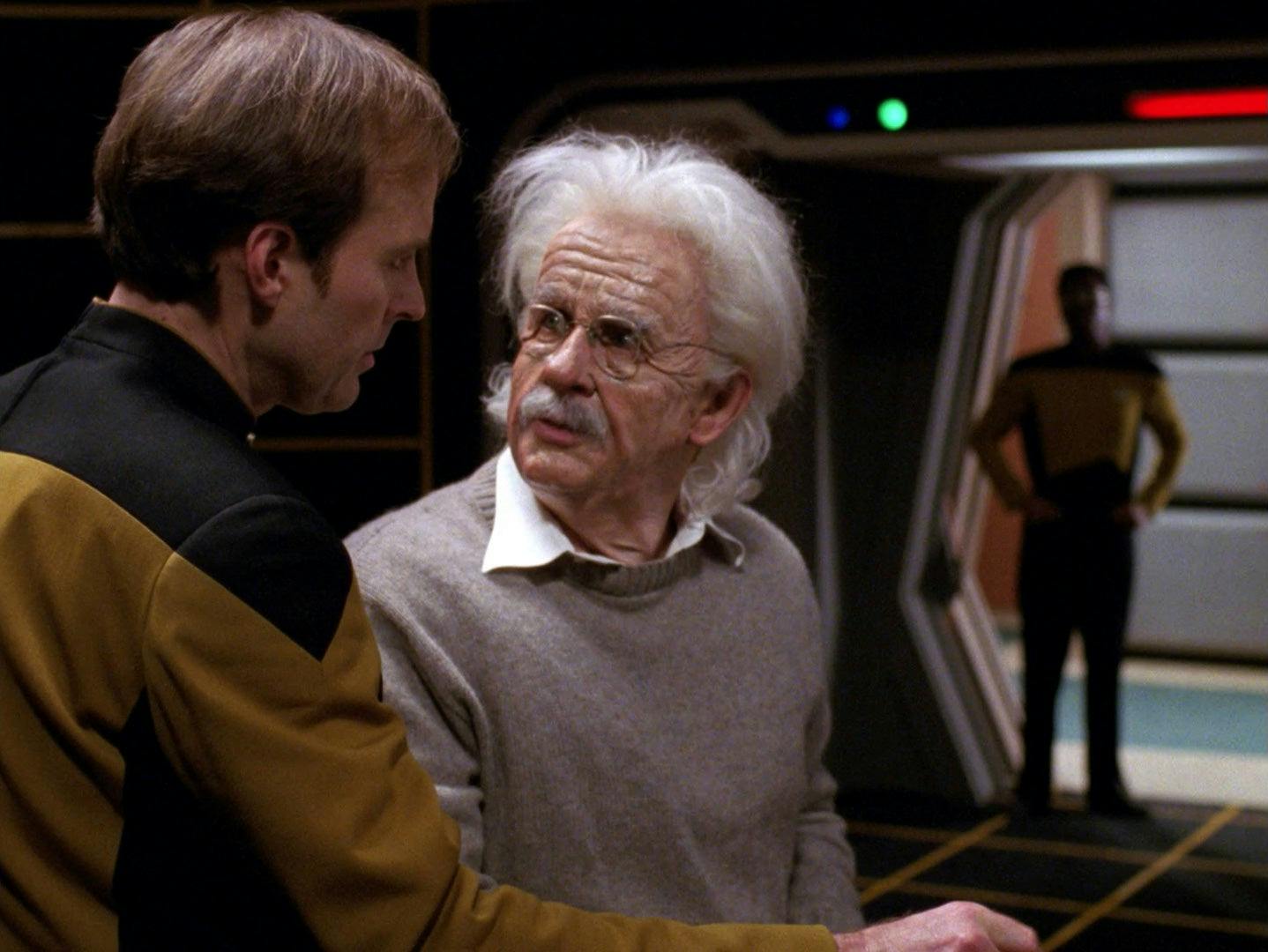
“In some respects, we are already there,” says McIntosh. “We now have a huge range of experiences in VR. Many of these track our head, hands, sometimes body and even eye movements so accurately that the 3D worlds rendered in real-time trick our brains into believing that we are physically present.”
McIntosh explains that incredibly sophisticated ‘holophonic’ sounds are able to replicate the position, movement, and dynamic quality of real-world sounds—to the level that people genuinely can’t tell what’s real and what’s virtual. “I have often witnessed people lifting and replacing their headphones to try to work out if the sounds they are hearing are ‘in or out’ of the story world,” she tells us. You don’t get more present than that.
There still remain several significant obstacles between today’s VR and the hyper-real experiences of the holodeck. The first is the fidelity of our vision. In other words, how real can we make what we see inside a VR headset look?
Most people are amazed by their first VR experience, whilst recognizing that it still doesn’t come close to our visual experience of the physical world: “Even the fanciest headsets cannot yet encompass our natural field of view. The resolution achieved is nowhere near that of the human eye,” McIntosh explains.
The color spectrums and black levels in most VR headsets is worse than most TVs, and having images rendered more than 60 times per second in each eye can make a virtual world today “look more like PlayStation 2 games circa 2002,” says McIntosh. We cannot yet forget that we’re still looking at a screen.
Another major challenge for VR is in reproducing the tactile sensation of touch. Unless somebody is able to crack the code to create ‘holomatter,’ how do we reach out and touch a virtual object?
We spoke to David Parisi, Associate Professor of Emerging Media at the College of Charleston and author of the book Archaeologies of Touch, who told us about ‘sensory capture.’ This is when tech is used to “envelop and enclose the senses, through a headset and headphones and bodysuit, with sensory input being taken over by a computer-generated apparatus.” The more complete this takeover of our senses is, the more complete our sense of immersion.
Imagine being able to stand beneath a virtual thunderstorm and feel the rain on your arms because you’re wearing a long-sleeved shirt that creates small haptic vibrations to simulate the droplets as they land. Or working at a virtual canvas and feeling the paintbrush between your fingers because you’re wearing gloves that apply the perfect amount of pressure to your fingertips. Haptic technology such as this, which helps to ‘envelop’ our senses, already exists.
The Teslasuit uses electrical impulses to simulate touch all over the body. Parisi explains that this kind of tech is a big step forward but currently isn’t ideal. “It’s uncomfortable for anything more than short bursts,” he explains.

Whether it’s a full-body suit or a single headset, discomfort continues to be a common complaint in the VR space. The tech we currently use to step into virtual worlds is still fairly restrictive, as well as not being inclusive of all body types. And physical irritations that arise from the tech pull us out of the virtual experience. It’s hard to convince yourself you’re playing pool at a bar in the south of France if your face is throbbing from having a screen strapped to it.
Looking ahead, both Parisi and McIntosh imagine tech that can incorporate aspects of the physical world to create a hybrid ‘mixed reality’ experience — replacing the need to wear lots of cumbersome equipment. For right now, though, our brains already seem to be doing a lot of the “mental gymnastics” that help us to make VR experiences feel meaningfully realistic.
“We seem incredibly well adapted to pick up on minimal visual cues,” McIntosh says. ‘We infer stereoscopy, depth, motion, and material qualities from some pretty basic optical illusions.
“People who have tried VR often talk about what they experienced as though it actually happened to them ‘I did this’, ‘I went there’, ‘they whispered in my ear’,” McIntosh continues. “Maybe this is enough for now.” Our present-day VR tech may prove to be the historical equivalent of the VHS recorder, but the value it delivers is real and measurable. This means we could be a lot closer than we think to significant breakthroughs in the medium.
A holodeck that looks, feels, and functions like the ones we’re familiar with isn’t going to appear in our lifetimes — if at all. But the possibilities represented by virtual reality mean we may soon experience fully immersive virtual worlds and applications, which will not only benefit us here on Earth but could also be crucial to our success as we move further into outer space.
Becca Caddy (she/her) is a London-based journalist specializing in tech, science and the future. Her first book, Screen Time, was published in January 2021. You can follow her on Twitter @beccacaddy.
Get Updates By Email
Star Trek: Ranking the 20 Best Holodeck Episodes
Star Trek's taken a trip or two (or twenty) to the holodeck on occasion; now, CBR takes a moment to reflect on the greatest of those adventures.
When Star Trek: The Next Generation opened, it showed a dramatic upgrade in technology for the Federation. One of the biggest advancements was the holodeck. Inside a relatively small room, a fantastic three-dimensional recreation of any setting could be created. It could be anything from an alien world to various Earth periods, nailing it all down to the smells of the area. The figures inside could feel as real as anyone and it paved the way for major stories. TNG used it a lot while Deep Space Nine had Quark running holo-suites with some rather….intimate programs available for customers. It was home to the popular Vic Fontaine and other programs. Voyager also used it a lot which made sense as, so far from Earth, the crew needed something to indulge in for relaxation.
Of course, the holodeck has given a few duds in various episodes. “Fair Haven” and “Spirit Folk” are two of Voyager’s worst episodes. While it was historic for exploring the holodeck, TNG’s “11001001” has not aged well. But when it works, the holodeck can be a big deal. After all, it helped set up the EMH Doctor who became a major Voyager character and the fun of these unique adventures has led to some good storylines. Yes, the trope of “holodeck malfunction endangers the crew” could be a cliché but the writers kept finding ways to twist it around. In a few occasions, the holodeck could be used for an episode that’s nothing but pure wild fun. Here’s how 20 of the best holodeck-themed episodes rank in Star Trek lore to show how even in the far future, folks love to indulge in great distractions.
20 HIS WAY, DS9
The sixth season of DS9 introduced what would become a major recurring character in Vic Fontaine. Played by James Darren, Vic was the suave owner of a 1960s Las Vegas casino he also headlined as a singing star. The crew came to love hanging out there to the point of letting the program run full time. In this debut episode, Vic knows he’s a hologram but uses it to try and help others with their issues. This includes how he’s able to tell Odo has been in love with Kira for years and she is starting to feel the same way. He even gets Odo with a holographic singer who looks like Kira but Odo dismisses it as not being real.
In a flash of inspiration, Vic invites Kira to dinner at his club. He then tells Odo that an “improved” hologram of Kira will be his date. They have a nice dinner and even a dance before realizing how Vic set them up. At first, they’re both upset but it does get them to finally face up to their feelings. This leads to the classic scene of them arguing about another date, each snapping at the other on how to act before finally kissing in front of the entire Promenade. It was a key moment for both characters thanks to a holographic match-maker.
19 FLESH AND BLOOD, VOY
At the conclusion of “The Killing Game,” the Voyager crew made peace with the Hirogens by giving them holographic technology. Janeway figured it was better for the Hirogens to hunt holograms than actual beings. In this two-part tale, the ship discovers a disabled Hirogen vessel. It seemed the Hirogens programmed the holograms to be as deadly as possible in order to be challenging prey. This blew up in their faces as the holograms have developed true intelligence and are able to turn the tables on the Hirogens. The Doctor is soon captured by these holograms, led by Iden. The Doctor is horrified to realize these holograms actually feel pain and even death and keep being brought back so it’s no wonder they’re lashing out at their creators.
Even as the Voyager crew aid the Hirogens, the Doctor starts to think the holograms have an actual point and aids them. But the Doctor becomes troubled as to how the holograms worship him so openly and how Iden is ready to wipe out the Hirogens to gain his freedom. It’s an intriguing tale tackling how holograms can become individuals, warts and all and even the Doctor is swayed by that. As Janeway points out at the end, the Doctor making mistakes and overcome by his emotions just proves he’s becoming more like a real human.
18 NOTHING HUMAN, VOY
This episode opens in a light way as Chakotay and Harry enjoy the rest of the crew forced to listen to one of the Doctor’s lectures. The humor ends when Torres is attacked by a deadly parasite. Even the Doctor is having trouble figuring it out so goes over records to find a biologist named Crell Moset whose research can help. He creates a hologram of the scientist who bonds with the Doctor as they try to find a cure. However, a Bajoran crewmember reveals that Moset was a Cardassian war criminal who was responsible for horrific experimentation on thousands of innocent people.
Thus, an ethical debate rages on whether a hologram should be held responsible for the crimes committed by the real person. There’s also how Tom insists on ignoring it to save B’Elanna but Torres herself says she’d rather die than owe Moset her life. Moset doesn’t help his case by stating that those experiments were simply science. While the episode has Torres surviving, the Doctor must make the final judgement on Moset to show how a holographic Cardassian can still be deadly.
17 BADA BING BADA BANG, DS9
Knowing they were about to embark on the massive nine-episode storyline that would conclude the series, the DS9 writers decided to do one last funny one-off episode. Bashir and O’Brien are visiting their beloved Vic Fontaine program when Vic rocks them by revealing he’s been forced to sell his casino to some mobsters who have turned it into a cabaret. O’Brien figures they can just rewrite the story only to find the program won’t let them. The crew realize that to save Vic’s place, they need to act out a 1960s type plot within the storyline. At first, Sisko can’t believe they’re treating this so seriously but realizes the crew thinks of Vic as a friend and agrees to help.
Thus, we have a Star Trek version of Ocean’s 11 as the crew dress up in full ‘60s regalia to pull off a complex heist. The sight of Dax as a cigarette girl and Kira dressed up to flirt is great. Even Sisko gets into it as, to the amazement of everyone, he actually starts singing as a distraction for the scheme. The plot itself is a brilliant scam that uses the holodeck technology to pull off an ace bait-and-switch. It was one final gasp of humor before DS9 got darker but it was a great romp.
16 THE KILLING GAME, VOY
This two-part episode has its detractors but still intriguing for the set-up. Once again, the Voyager crew tangle with the Hirogens, a race who are obsessed with hunting other species. Having taken over the ship, the Hirogen leader comes with a unique idea. He has the crew mind-wiped and then put into constant holodeck scenarios based on Earth wars that the Hirogens can use for hunting. The latest is a World War II setting where Janeway is a spy/club owner, Seven a spy/singer, Torres a French girl and the rest of the gang Allied soldiers.
Putting the crew into a WWII setting makes for some intriguing set-ups with Janeway and Seven showing off a bit more. There’s the tension of the Doctor and Harry figuring out a way to free the crew from this situation. Even the Hirogens come off nicely, their commander seeing the Voyager crew as “worthy prey” and the touch of how they actually despise having to act like Nazis. The ending paves the way for the episode “Flesh and Blood” while showing the darker sides of the holodeck.
15 TINKER, TENOR, DOCTOR, SPY, DS9
The opening should make it clear this is a holodeck episode. First, there’s how everyone in the mess hall is utterly enthralled by the Doctor’s beautiful singing. Tuvok breaks out into tears and only the Doctor can calm him down via song. It seems the Doctor has taken to “daydreaming” which means he’s created a link to the holodeck to live out fantasies of being a hero. This includes a wild scenario where Janeway is taken down and the Doctor activates the “Emergency Command Program” to take command. He also imagines Janeway and Seven fighting for his attentions.
Naturally, the Doctor is humiliated when the crew stumble onto his dreams. What he doesn’t realize is that an alien has been tapping into the holodeck but mistaken the dreams for reality to order his race to attack Voyager . The guy realizes the truth and this could be a disaster if his people attack. Convinced of the threat, the crew decide to use the misconception and have the Doctor pose as the Captain to trick the aliens. It’s soon clear the Doctor is more the hero in his fantasies then in reality which nearly ruins things. While it’s funny watching the Doctor playing hero, the episode is also a good step to how the character was accepted as a real individual by the crew.
14 BOOBY TRAP, TNG
This season 3 episode has the Enterprise arriving in an area of space to find a ship from a war that wiped out two races centuries before. Picard is excited to visit it but his joy fades when the Enterprise’s engines shut down. Somehow, they’ve triggered the same “booby trap” that ruined that other vessel and have to figure a way out of it. Geordi is attempting to figure out the engines and goes over the data of Leah Brahams (Julie Warner), the scientist who created them. To aid him, Geordi has the holodeck craft a version of Leah to give advice.
At first cold, the holo-Leah has some personality put into her and she and Geordi get along. They even share a kiss with Geordi realizing he has to end it fast as Leah does give him the solution to save the day. Warner was quite good in the role and a nice chemistry with Geordi. This paid off in “Galaxy’s Child” where Geordi met the real Leah, who was far more arrogant and stand-offish and was not happy seeing this holographic version of her. Even with holographic ladies, Geordi can’t catch a break.
13 A FISTFUL OF DATAS, TNG
Some fans argue about this episode but it does provide a great showcase for Brent Spiner. Worf is trying to find some bonding time with son Alexander and suggests the holodeck. Rather than engaging in classic Klingon battles, Alexander talks his father into an Old West simulation and Troi joins them. Worf is barely inside when the inevitable malfunction occurs thanks to how Data is being plugged into a ship interface. As a result, several of the key holodeck characters all now look like Data from the wicked gunslinger to a bandit to even a saloon dancer.
The sight of Worf in cowboy gear is good but better are the various Datas. Seeing the android talk in a variety of accents from Western to Mexican is fun and Spiner clearly is enjoying himself. There is some drama as Worf knows Data has better reflexes, making a showdown with him very dangerous. But we get some good bonding between Worf and Alexander and even Troi seems to be having fun in cowboy clothing. The ending is nicely done to make this a fun showcase for holodeck zaniness.
12 ELEMENTARY, DEAR DATA, TNG
Data as Sherlock Holmes is a rather brilliant idea. Geordi is looking forward to being with Data as his Watson but is annoyed as Data’s computer mind means he can instantly figure out a mystery fast thanks to having read all the Holmes stories. Inspired by Doctor Pulaski, Geordi instructs the computer to craft a foe even Data would have a tough time against. Of course, it’s Professor Moriarty (Daniel Davis) who leads the two through a fun mystery. But things take a turn when Moriarty asks an abducted Pulaski just what the Enterprise is.
The computer decided to interpret “an equal foe to Data” to mean making this Moriarty as smart as possible…so smart that he understands he’s just a hologram on a ship. Davis is fantastic in the role as a cultured villain fascinated by this mystery. It threatens the actual ship until Data is able to talk Moriarty into accepting his place in the holo-matrix. This episode laid the groundwork for how holograms could be actual beings in their own way and also set up a fantastic sequel a few seasons later.
11 THE BIG GOODBYE, TNG
This was one of the first major holodeck episodes and (amazingly) is the only TNG episode to win a Peabody Award. To the surprise of the crew, the cultured Captain Picard loves to play Dixon Hill, a rough and tumble 1940s private eye. Crusher is with a historian who join Picard in an adventure, seeing it as just a good time. The historian gets a bit too much into it, goading some of the holographic gangsters, confident as this isn’t real. He’s thus shocked when one of them shoots him. It turns out a solar accident has caused the first (but far from the last) holodeck malfunction to seal the crew inside and disengage the safety protocols.
Things get more serious with Picard breaking character to tell the characters they’re just holograms. The main gangster doesn’t believe it but when the holodeck is fixed, he and his colleague attempt to leave, only to vanish into nothing. There is a dramatic bit as one of Dixon’s allies asks Picard what happens to him when the program is off and Picard realizes the guy thinks of himself as a real person. This was the first episode to explore the holodeck as an actual setting and one of the bright spots to the otherwise rough first season of TNG .
10 REAL LIFE, VOY
The Doctor’s quest to understand humanity was at the core of his character on Voyager . In “Real Life,” the Doctor decides to embark on a family existence by creating a holographic wife, son and daughter. Kes and Torres show up for dinner where they realize the family are straight out of a 1950s sitcom. Torres tells the Doctor they’re just “too perfect” and totally unlike any actual family out there. He decides to program in some “realistic” character touches. Soon, he has a wife too busy with her own career and two teenagers acting up majorly.
The Doctor does his best to handle it but things just amp up with one kid hospitalized and facing “death.” At the same time, Paris is injured for real and the Doctor thinks this “family drama” will keep him from doing his job. Paris informs him how real life means taking the good with the bad and thus the Doctor has to handle this. It’s a more dramatic episode then it seems to show how even a holographic family can pack a punch.
9 WORST CASE SCENARIO, VOY
The opening act of this Voyager episode is gripping. Torres is approached by Chakotay who tells him that “things are going to change” and wants to know what side she’s on. Chakotay takes advantage of Janeway being off-ship to pull off a mutiny, arguing that it’s the best way to get to Earth. The fact that Seska is not only alive but looks Bajoran should be a tip-off this is fake. As it happens, Torres stumbled onto a holodeck program of a mutiny. Before long, it becomes a popular game for the crew who are thrown to find it has no ending. It turns out the whole thing was created by Tuvok as a training exercise when Voyager first began its trip.
Pressured to end the story, Tuvok and Paris head to the holodeck which then seals behind them. The ever-conniving Seska found the program and her avatar announces that she’s going to finish it her way. All the safeties are off so Tuvok and Paris find themselves in serious danger as Seska and her holographic crew hunt them down. The rest of the crew have to find a way to alter the program’s story to let the two survive. As Paris openly states, even a holographic Seska is a major pain for the Voyager crew to handle.
8 IT’S ONLY A PAPER MOON, DS9
DS9 went to darker places than other Trek series so it’s no surprise one episode openly tackles the issues of PTSD. Having lost a leg in battle in an earlier episode, Nog returns to the station, naturally quiet and withdrawn. The crew understand and are willing to help. Nog turns to Vic Fontaine’s program for some release and hangs out there. He then shocks everyone by moving into one of the hotels of the program. Indulging in fantasy is one thing but literally living there shows Nog has some problems.
Even Vic recognizes it, openly telling Nog he can’t just live in a 1960s world for the rest of his life. Nog just gets into it more, even becoming Vic’s “accountant.” When Nog won’t let go, Vic decides to give him a wakeup call by shutting his own program down. He makes Nog realize that sinking into fantasy can just hold him back from actually living his life. It’s a daring take on a serious issue that DS9 manages to pull off nicely.
7 TAKE ME OUT TO THE HOLOSUITE, DS9
The final season of DS9 is packed with grim stuff thanks to the war with the Dominion. So it’s notable it also has one of the funniest episodes of the series. Sisko meets with Solok, a former classmate at Starfleet Academy. The two have long been rivals thanks to Solok’s belief Vulcans are superior to humans at anything. He decides to prove it by challenging Sisko to the exclusively Earth game of baseball. Sisko agrees, confident his crew can handle any challenge. It’s not until they head to the baseball holosuite that Sisko realizes a tiny flaw in his plan: he’s the only one who has the slightest idea how to play the game.
Watching Sisko, a man who has handled Cardassians, Jem’Hadar and other enemies with cool resolve, completely lose it over baseball is hysterical. The crew are just totally inept at everything from ball play to banter (Worf: “Death to our enemies!”) to drive him crazier. There’s also Odo taking his role as umpire a bit too seriously. The game is a riot just for the sight of the crew in uniform and the fact they’re losing for most of it. However, it ends up bonding them together to show how a simple sports game can help even the darkest of times.
6 LIVING WITNESS, VOY
Technically, it’s not the regular holodeck but it does count. The opening act is jarring as we see the Voyager crew who are basically a pack of murderous thugs with an android Doctor and a Seven who’s still a full Borg. The crew are allied with the Vaskans to steal materials and brutally wipe out an attacking wave of Kyrian forces. It turns out this is all the “holographic records” of a Kyrian museum showing what happened 700 years earlier. Historian Quarren has grown up accepting Voyager as monsters who nearly destroyed his race. Going over some old evidence, he accidentally awakens the holographic Doctor.
The Doctor is appalled to see the “records” showing the crew as villains (“somewhere across the galaxy, Captain Janeway is spinning in her grave”). He then shows what really happened in that it was the Kyrians who were the bad guys attacking the noble Vaskans and their “great martyr” was a total thug. This causes massive riots across the planet but Quarren and the Doctor are determined the truth is more important. The ending reveals this is all another holographic record but one showing two men fighting to help their world achieve a new peace. The opening is good but the rest of the episode has the holodeck programs used to highlight the old “history is written by the winners” mantra.
5 FUTURE IMPERFECT, TNG
This often ends up on lists of the best TNG episodes. On his birthday, Riker is beaming down for a mission only to wake up in sickbay with his hair grey and being called Captain. Crusher tells Riker he’s dealing with the effects of an illness that’s caused him to lose memory of the last 17 years. Riker is now captain of the Enterprise with Data his first officer; Geordi can see without his VISOR; a Ferengi is at the helm; Picard is an admiral; and Riker has an 11 year old son. Riker is told he has to handle a peace meeting with old Romulan foe Tomalok.
Various odd bits make Riker suspicious of all this. The kicker is when he’s shown videos of his supposedly late wife…and realizes it was a woman from a holodeck program. This leads him to expose how this is all a Romulan plot to trick Riker into giving up secret information. His “son” is a real orphan as they go on the run. But there’s one more twist to come that changes the game majorly. Fans love the look at this supposed future and a good spotlight for Riker while showing the nice twists a holodeck is capable of.
4 HOLLOW PURSUITS, TNG
When we first see Reginald Barclay (Dwight Schultz), he’s a tough guy in Ten Forward who ends up punching out Riker in a fight. It turns out to be a holodeck program as Barclay is a truly brilliant engineer but a social wreck and can only live out his dreams in holograms. LaForge is concerned so he, Riker and Troi check out Barclay on the holodeck. There, they find his programs which are always intended to make himself the hero of things. That includes one of the main crew as the Three Musketeers who hail Barclay as a hero.
A hilarious bit has Troi saying this is no big deal…then sees how Barclay has a version of her that’s obviously in love with him (her “muzzle it” to “herself” is priceless). LaForge notes how Barclay’s addiction to the holodeck is damaging and holding him back from being himself. As it happens, an emergency pushes Barclay to finally stand up and assert himself to save the day. He bids farewell to the holodeck (except for one special program) to try and live his life. It’s a great parody of some Trek fans but also introduced the popular Barclay character to make it more important.
3 SHIP IN A BOTTLE, TNG
It took a while but someone in the TNG writer’s room finally remembered “Elementary, Dear Data” and decided it was time for a follow-up. Going over old holodeck programs, Barclay is thrown to revive Professor Moriarty who knows what he really is. Moriarty then shocks everyone by actually being able to leave the holodeck, using the idea that because he believes himself to be a real person, he truly is. As they try to figure things out, Moriarty wants them to also allow his love, Countess Regina Bartholomew, to become real.
When the crew refuse, Moriarty takes control of the Enterprise and threatens the ship. Of course, there comes the twist: Data realizes that Moriarty never left the holodeck. Rather he, Picard and Barclay are stuck in a massive program as part of Moriarty’s plan. As before, Daniel Davis is magnificent as a Moriarty you can root for and obviously wanting to be a person of his own. The ending throws in one more twist to set it right and caps off a fine sequel that shows how tricky the holodeck can truly be.
2 OUR MAN BASHIR, DS9
Airing right around the time of the release of Goldeneye , it’s pretty obvious what the inspiration for this tale is. Garak drops in on the holodeck to find Bashir engaging in a program where he’s a suave James Bond-style 1960s secret agent. When Kira (with an outrageous Russian accent) pops in, Bashir assumes she’s joining the fun. In reality, an accident has caused Kira, Sisko, Dax, Worf and O’Brien to somehow be integrated into the characters of the program. As leaving the holodeck might kill them for real, Bashir and Garak have to play out the program
It’s obvious the actors are enjoying this spy thriller. The biggest is Avery Brooks who goes wonderfully over the top as the Bond-like super-villain with the typical “destroy the world” plot. There’s also the comedy in how Garak, an actual experienced spy, is thrown at this romantic tale (“Kiss the girl, get the key, they never taught that in the Obsidian Order”). The ending is a bit more dramatic with Bashir making a surprise move to save the day. Sadly, we never lived up to Bashir’s promise that “Agent Bashir will return” but this just makes this episode stand out more for showing Bashir’s more dashing side (and how Alexander Siddig might have made a good Bond).
1 BRIDE OF CHAOTICA!, VOY
Hands down the funniest episode of Voyager , this is nothing but a pure romp. For some time, Tom has been obsessed with “Captain Proton,” a holodeck program playing like a 1930s sci-fi movie serial. He’s jarred when he shows up to find actual casualties lying around. It seems a portal has been opened to another dimension where those aliens have mistaken the enemies of the serial for reality and launched a “war” upon them. This is causing messes to Voyager’s systems from replicators to engines and it could be major trouble if it’s not handled. Tom naturally comes to the conclusion they need to aid the holograms by acting in character.
So we have fun bits like the Doctor using his inner ham for the “President of Earth” and the sheer ridiculousness of Tom straight-faced explaining this entire situation to his amused colleagues. But nothing can top the sight of Janeway dressed up as the wicked alien queen Arachnia. It’s clear Kate Mulgrew is having the time of her life with Janeway at first annoyed but then getting into this act of an evil ruler and going gloriously camp. Having much of the episode in black and white just aids the zany joy. It’s a clear delight and one of the best uses of the holodeck in Trek history.

Fantasy Science Pt. 20: How Do STAR TREK’s Holodecks Work?

- Facebook Data not found. Please check your user ID. Twitter You currently have access to a subset of Twitter API v2 endpoints and limited v1.1 endpoints (e.g. media post, oauth) only. If you need access to this endpoint, you may need a different access level. You can learn more here: https://developer.twitter.com/en/portal/product Youtube 1.1K

FEMME: An Agressive Gay Revenge Film

HUMANE: Caitlin Joins The Cronenberg Family Business
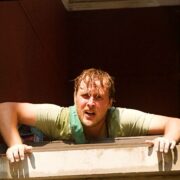
STRESS POSITIONS & Interview With Theda Hammel & John Early

ISA TOP 25 SCREENWRITERS TO WATCH Interview With Kathryn Orwig

AMAR SINGH CHAMKILA: A Spiced Venture Of The Formulaic Music Biopics

TRAP Trailer

ENTER FOR A CHANCE TO WIN THE DEPARTED DIGITAL MOVIE!

Interview With Dylan Baker for LAROY, TEXAS

ISA TOP 25 SCREENWRITERS TO WATCH Interview With Thuc Doan Nguyen

Interview With Screenwriter Alessandro Camon For THE LISTENER

NO WAY UP Represents The Democratization Of Bad Underwater Thrillers

MONSTER: The Truth About Youth

Radha has a PhD in theoretical quantum physics. Apart from…
Force fields. Holography. Augmented reality. Have you heard terms like these flying around the science fiction sections of the film/TV world? Have you ever wondered just how accurately these films portray real science? Well, my friends, today is your lucky day: this column, Fantasy Science & Coffee , aims to bridge the gap between science and science fiction in films and popular culture. My hope is to explain things in a fun way – like we’re chatting over coffee.
You may be thinking: who is this person, why does she think she can explain science, and why the heck would I want to have coffee with her? Well, I’m Radha, a researcher in India, who recently submitted a PhD thesis in theoretical quantum physics. I quite like hot beverages. I’ll also pay.

In this twentieth part of the series published on the second and fourth Tuesdays of every month, we are going to look at how Star Trek’s iconic holodecks work!
Holodecks in Star Trek
If you’re an avid reader of fiction, you likely enjoy the feeling of diving into a different world to get away from real life. In Star Trek, this is literally possible with holodeck technology. It’s one of my favourite narrative tools in the Trek universe, because there’s so much story potential: it can be used for recreational storylines, for serious training through realistic simulations, or even for alien encounters such as those with photonic beings in Voyager .
Holodecks are used to create very realistic environments that one can interact with tangibly. Here’s a clip from The Next Generation in which Data introduces Commander Riker to the holodeck:
In order to generate these complete, fictional worlds, holodecks make use of programs. Human holograms can be programmed to be as complex as real humans, responding to people based on their programmed characteristics. Creating these programs is an art, akin to present day publishing; one of the coolest concepts in Voyager is the holonovel.
Captain Kathryn Janeway, in order to deal with the stress of being a captain, often turns to the holodeck to unwind. In a few episodes, she takes part in a holonovel, in which she becomes a Jane Eyre-esue governess for a rich man with two children.
Later in the Voyager series, Lieutenant Tom Paris creates the Scottish township of Fair Haven, as a place for the crew to unwind. He prides himself on the detail he put into everything, including the holographic townsfolk.
https://www.youtube.com/watch?v=mqkFbxBbus4&t=4s
What makes the holodeck truly remarkable is that despite being a moderately sized room, two people do not have to visit the same place in the fictional world. If Tom Paris wants to visit Fair Haven’s seaside, and Harry Kim wants to explore the castle on the hills near the village, they can do so simultaneously. They can be kilometers apart, but do not run into each other, nor the room’s walls. They cannot, however, access two different holodeck programs simultaneously; only one is allowed to run at a time.
What makes the show creators’ holodeck idea even more remarkable, is that there’s a very realistic explanation behind holodecks: its science is explained in the Voyager Technical Manual.
The technology is based on two concepts: 1) holographic imagery with force fields to project illusions for the human participant, and 2) replicator technology (the matter conversion subsystem) to convert energy to matter so that participants can actually feel the things they touch.
Brief Overview: Force Fields
Let’s take a look at the first concept. One can think of a force field as a map of how a force acts on a particle at each point within a certain space. For instance, the force fields generated by the holodeck are confined to within its walls, thus they do not have any influence beyond that room.
A force field is represented by curved or warped lines, to show just how the force acts along those paths. As an example, look at the magnetic field lines around a theoretical magnet (on the left). The arrows indicate the direction along which the force acts for each point on that path.

We can physically see this with iron fillings scattered over a real magnet (on the right). The magnetic field acts on them and arranges them in a way that we can actually see the field lines!
How Holodecks Work
Now that we have force fields down pat, let’s look at how the holodeck creates a tangible environment. This image, taken from Voyager’s technical manual, provides a nice explanation about how holodeck technology works:
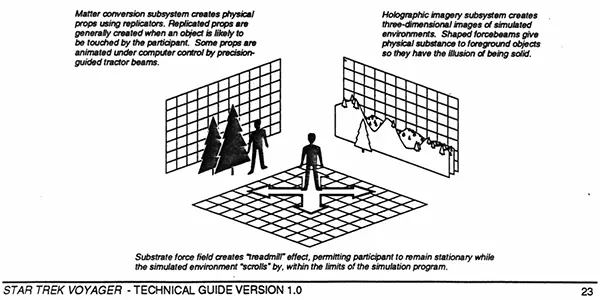
The force fields, along with the replicator technology, constantly adapt to give a human participant the feeling of moving through space, without her actually moving very far, in much the same way a treadmill does. Rather than the participant moving around the room, the imagery provided by the holographic projectors warp to give her the visuals she expects to see, and the ground under her feet continuously replicates to make her feel like she’s walking.
A good example of this constant adaptation is when B’Elanna Torres goes skydiving in the Voyager episode “Extreme Risk”. When she jumps, the force fields compensate, giving her the feel of rapid free fall of hundreds of kilometers.
She prematurely ends the program before hitting the ‘ground’. It’s seen that she had been hovering a few feet above the floor of the holodeck all along. The holodeck safety controls soften her landing.
Real Life Tech
While we are far from being able to create tangible objects the way Star Trek’s replicator technology does, interesting strides have been made towards immersive virtual experiences. You may be familiar with the Oculus Rift, a virtual reality headset. Another really cool technology is that of augmented reality, which Pokemon Go players are familiar with, since a particular mode allows Pokemon to appear as though they are in one’s own surroundings. One of my favourites is Quartz’s iPhone app . I low key hung out with the Lunar Rover recently thanks to this app!
The extent of today’s technology, and the interesting strides in research and development are a tad long to be addressed here, so I’ll save those for a later date. Instead, I’ve linked below to a few interesting resources you may like to explore.
Before you leave, however, I have a question for the bibliophiles out there: which novel would you love to see converted to a holonovel?
More to Explore
The Telegraph: Amazon to ‘revolutionise’ shopping with ‘virtual changing room’ app (2019)
Harper’s Bazaar: Cher’s iconic computerised wardrobe could soon become a reality (2019)
BBC: How Spatial and augmented reality could change work (2019)
TrekMovie: Roddenberry Entertainment Joins Project To Build Real Star Trek-like Holodeck (2018)
Variety: A First Look at Light Field Lab’s Futuristic Holographic Display (2018)
Technologies/Apps
Light Field Lab
Does content like this matter to you?
Become a Member and support film journalism. Unlock access to all of Film Inquiry`s great articles. Join a community of like-minded readers who are passionate about cinema - get access to our private members Network, give back to independent filmmakers, and more.

Radha has a PhD in theoretical quantum physics. Apart from research, she consults on sci-fi screenplays/books. In her free time, she cosplays and irritates her three cats. Bug her on Twitter: @RadhaPyari
SXSW Film Festival 2024: MY SEXTORTION DIARY
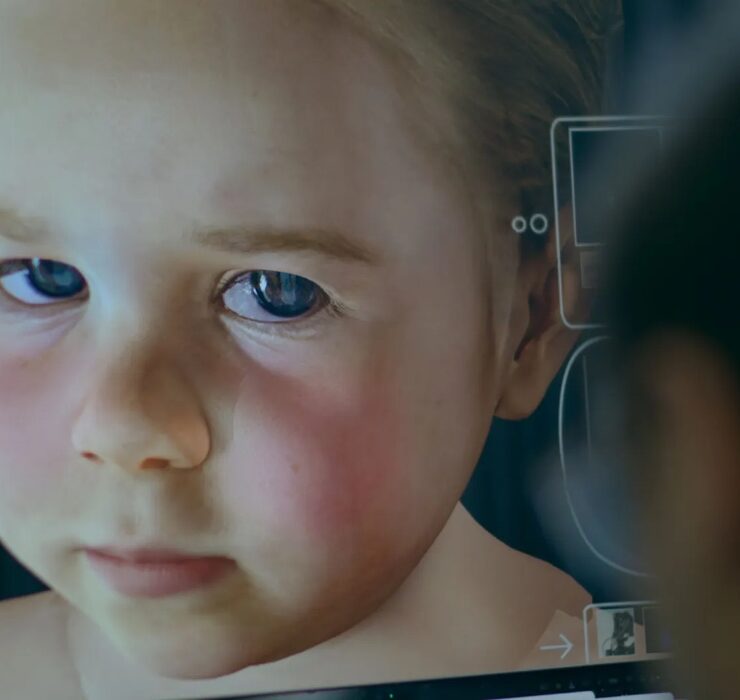
Sundance Film Festival 2024: ETERNAL YOU
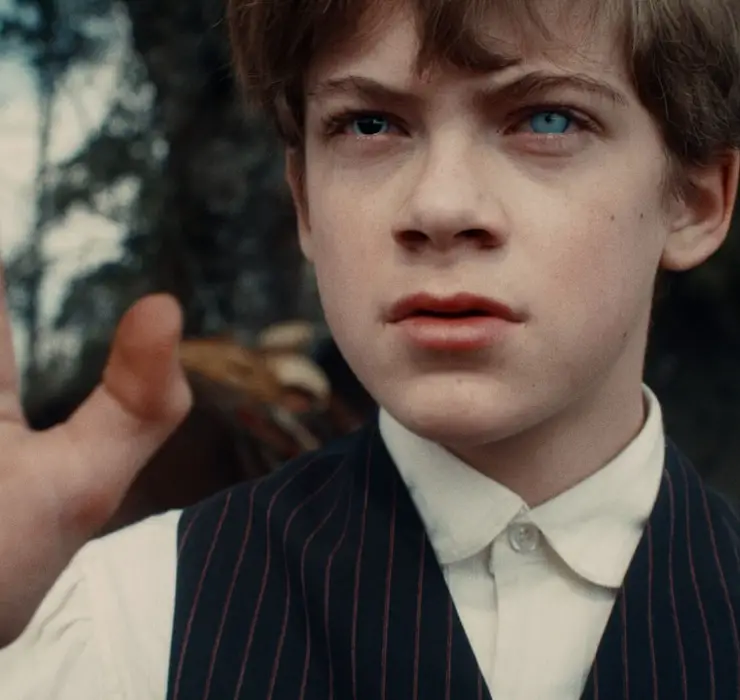
IN THE FIRE : An Enigmatic Battle Between Science And Religion

San Francisco International Film Festival: Documentary Round Up Part 1
- Write for Us
- Become a Patron
- Comment Policy
- Terms & Conditions
- Staff Login
© 2023 Film Inquiry. All Rights Reserved.


Enterprise’s Holodeck Is Star Trek’s “Most Imaginative” Invention, Says TNG Producer
- The holodeck in Star Trek: The Next Generation allowed the characters to have fun and explore different genres, like playing Sherlock Holmes.
- Despite malfunctions, the holodeck provided some of the most enjoyable episodes in Star Trek, creating genuine friendships among the characters.
- The holodeck not only enabled the show to experiment with genres but also raised interesting philosophical questions through self-aware programs like Professor Moriarty.
The holodeck turned out to be one of the greatest inventions introduced in Star Trek: The Next Generation , and TNG co-producer Brannon Braga knew a good idea when he saw one. Captain Jean-Luc Picard (Patrick Stewart) and his crew on the USS Enterprise-D embarked on all kinds of adventures throughout TNG's seven seasons, and the holodeck provided some much-needed recreation. Not only was the holodeck an incredibly cool piece of technology, it also allowed the writers of TNG to play around with various genres. Whether Lt. Commander Data (Brent Spiner) wanted to play Sherlock Holmes or Captain Picard wanted to play a hard-boiled detective, the holodeck allowed the characters and the actors to have some fun.
Despite its tendency to malfunction, the holodeck provided Star Trek with some of its most fun episodes across multiple serie s. TNG 's holodeck gave Star Trek: The Next Generation 's characters the opportunity to interact with one another outside of their roles on the Enterprise, allowing them to form more genuine friendships. In the Star Trek oral history, The Fifty-Year Mission: The Next 25 Years by Mark A. Altman and Edward Gross, TNG co-producer Brannon Braga discusses the holodeck and the impact it had on the show. Read his quote below:
The holodeck is one of the most imaginative, maybe even underappreciated inventions. This cyber-reality, forward-thinking idea, at least for TV, was fantastic. Very early on in the series Gene had Picard and Data playing Sherlock Holmes characters. They were recreational, they hung out whether it was the holodeck or the poker game. I don’t think that special camaraderie would have evolved without it—I think eventually Picard and Data would have a special bond, as did Picard and Worf, and the characters start to click together. Everybody had their thing.
Star Treks 20 Best Holodeck Episodes
The invention of the holodeck led to some of star trek's best episodes.
Beginning with Star Trek: The Next Generation season 1, episode 12 , "The Big Goodbye," holodeck episodes became a staple of many Trek series. "The Big Goodbye" was one of the best episodes of TNG's rocky first season, and it set the precedent for many of the holodeck episodes that followed - for better and worse. It was always fun to see the characters of various Trek shows dress in period costumes and go on adventures, though the holodeck's regular malfunctions did put a damper on things .
While it doesn't make sense that the holodeck has safety protocols that can be disabled, the entertaining stories in the holodeck episodes made up for many of the less logical aspects.
Many of Star Trek's best friendships were cultivated on the holodeck, including that of Data and Lt. Geordi La Forge (LeVar Burton) on TNG , Chief Miles O'Brien (Colm Meaney) and Dr. Julian Bashir (Alexander Siddig) on Star Trek: Deep Space Nine, and Lt. Tom Paris (Robert Duncan McNeill) and Ensign Harry Kim (Garrett Wang) on Star Trek: Voyager . Not only did the holodeck allow Star Trek to experiment with different genres, but self-aware programs like Professor Moriarty (Daniel Davis) in TNG and The Doctor (Robert Picardo) in Voyager raised fascinating metaphysical questions. The holodeck remains one of Star Trek's best inventions, and it led to some truly iconic episodes.
Star Trek: The Next Generation is available to stream on Paramount+.
Source: The Fifty-Year Mission: The Next 25 Years: From The Next Generation to J. J. Abrams: The Complete, Uncensored, and Unauthorized Oral History of Star Trek by Mark A. Altman and Edward Gross
Star Trek: The Next Generation
Cast: Patrick Stewart, Marina Sirtis, Brent Spiner, Jonathan Frakes, LeVar Burton, Wil Wheaton
Release Date: 1987-09-28
Genres: Sci-Fi, Superhero, Drama, Action
Story By: Gene Roddenberry
Writers: Gene Roddenberry
Network: CBS
Streaming Service(s): Amazon Prime Video
Franchise(s): Star Trek
Directors: David Carson
Showrunner: Gene Roddenberry
Season List: Star Trek: The Next Generation - Season 1, Star Trek: The Next Generation - Season 2, Star Trek: The Next Generation - Season 3, Star Trek: The Next Generation - Season 4, Star Trek: The Next Generation - Season 5, Star Trek: The Next Generation - Season 6, Star Trek: The Next Generation - Season 7

Strange New Worlds' Futuristic VFX Tech Has A Delightful Star Trek Nickname
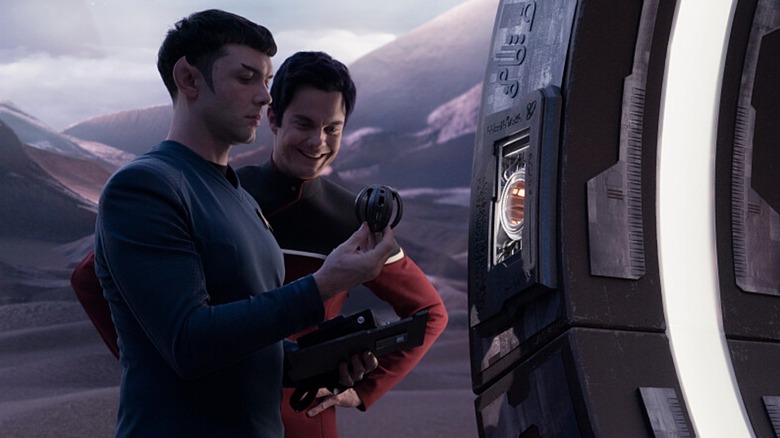
A Variety cover story about the future of "Star Trek" includes plenty of exciting updates about the future of the series, but it's also just a trivia treasure trove for "Trek" fans — including the ones who work on the shows. "Star Trek: Strange New Worlds" stars Anson Mount (who plays cool, calm, and collected Captain Pike in the series) and Ethan Peck (who plays a younger, slightly more emotive Spock) both noted how surreal their jobs are, while Mount also revealed that they get to go to work on a set named after part of a starship.
"Sometimes we call it The Holodeck," Mount told Variety when describing the massive augmented reality walls (similar to those used by Industrial Light & Magic's The Volume ) that turn the set into a virtual-physical hybrid space. Variety's Adam B. Vary observed that Mount "[couldn't] help but break into a boyish grin" when he talked about the AR walls they call The Holodeck, as if it's yet another childhood dream come true. In an interview with Entertainment Tonight back in 2019, Mount explained that he'd been a "Star Trek" fan since he was seven or eight, and said of his own casting, "It was almost like you had been sitting in the audience for a really long time and somehow you get sucked into the screen and then you're standing in the starship in front of a Klingon with a phaser in your hand."
The AR walls on set are nicknamed The Holodeck
The Holodeck title apparently isn't just a nickname among the actors; according to Variety, posters of the holodeck from "Star Trek: The Next Generation" adorn the walls along the path to the virtual set, along with the phrase "Enter Holodeck" written in a classic "Star Trek" font (though, sorry font geeks, there's no word on whether it's Galaxy or Horizon ). As with other virtual sets being used in Hollywood today, the AR walls known as The Holodeck utilize massive LED screens that display highly realistic, kinetic CGI backdrops. Mount says they're a bit dizzying.
"The images on the walls start to move in a way that makes no sense," the actor told Variety. "You end up having to focus on something that's right in front of you so you don't fall down." Peck, meanwhile, said he's not as bothered by the CGI walls, and wished he could take one of the Holodeck signs home. "I don't really get disoriented by it. Spock would not get ill, so I'm Method acting," he joked.

Virtual sets still need the human touch, and Trek's got it
While virtual sets were initially praised as a technology capable of revolutionizing film and television, it's become clear by now that not every production is made better by AR walls. "The Mandalorian" set the standard by coupling its realistic set graphics with great production design and cinematography, but movies like "Thor: Love and Thunder" (which didn't quite hit the background/prop ratio needed to look real) and shows like "Percy Jackson & The Olympians" (which, as the first production to use the Vancouver-based virtual set , has an uncanny valley shininess to it) prove it's not enough to let the sets do the work, no matter how magnificent — and disorienting — they are.
Luckily, though, "Star Trek: Strange New Worlds" seems to be firing on all cylinders. The first two seasons look great, and everyone from the costume department to the director's chair delivers the goods again and again. As "Trek" star turned director Jonathan Frakes put it elsewhere in the article, "Every department has the resources to create." We can't wait to see what they'll create next.
"Star Trek: Strange New Worlds" will return for season 3 on Paramount+ in 2025.
Log in or Sign up
You are using an out of date browser. It may not display this or other websites correctly. You should upgrade or use an alternative browser .
Something that really doesn't make sense in Voyager
Discussion in ' Star Trek: Voyager ' started by The Overlord , Jan 17, 2011 .
The Overlord Fleet Captain Fleet Captain
In an episode of first season of Voyager "The Cloud", they mentioned something that made no sense, that the power supply from the Holodeck is incompatible with the rest of the ship. Federation personal have been able to incorporate Cardassian and even Borg tech with their existing tech, but they can't get power from one part of the ship to another part of the ship. That makes no sense, they wanted to show the Voyager crew struggling with a lack of power, but still do silly Holodeck episodes, it doesn't work.
Dukhat Admiral Admiral
The Overlord said: ↑ In an episode of first season of Voyager "The Cloud", they mentioned something that made no sense, that the power supply from the Holodeck is incompatible with the rest of the ship. Click to expand...
Dukhat said: ↑ The Overlord said: ↑ In an episode of first season of Voyager "The Cloud", they mentioned something that made no sense, that the power supply from the Holodeck is incompatible with the rest of the ship. Click to expand...
froot Fleet Captain Fleet Captain
SchwEnt Fleet Captain Fleet Captain
Doesn't make sense. Yeah you got that right. Starfleet crews always find a way to access and interface any kind of alien tech they stumble across. Yet somehow, the Voyager is incompatible with its own power supply. Huh?? Absolutely ridiculous. And what a way to start a series about the "hardships" this stranded crew was gonna face. Between stuff like this, plus the Maquis and Starfleeters big conflict lasting about two eps, it seemed the whole premise of this series went out the airlock. These were big problems to me and not acceptable from writers and producers with extensive experience going back thru TNG and DS9. They should have known better and done better. I lost faith and interest, and really never went back.
Anwar Admiral Admiral
Look, if you wanted NuBSG that was never going to happen. NuBSG required them to be totally alone in the Universe except for the Cylons, and for them to be the sole survivors of their civilization with no hope of ever going home again. VOY is in a Universe that's totally loaded with lifeforms that can and would help them, wormholes or super-aliens who can easily send them home, and a home to return to as well. Plus the Maquis and Fleeters didn't have serious issues to work through in the first place. The premise itself was a little screwy, it made no sense that they couldn't make more torpedoes or shuttles on their own so they shouldn't have said they couldn't.
Mr. Laser Beam Fleet Admiral Admiral
Since it's in situations like this, where the crew is cut off from all contact with home, that the use of holodecks would be more valuable than ever (as a coping/psychological release mechanism), one would think that the holodeck systems would be one of the highest priority systems onboard, second only to life support...
Mr. Laser Beam said: ↑ Since it's in situations like this, where the crew is cut off from all contact with home, that the use of holodecks would be more valuable than ever (as a coping/psychological release mechanism), one would think that the holodeck systems would be one of the highest priority systems onboard, second only to life support... Click to expand...
Captrek Vice Admiral Admiral
The Overlord said: ↑ Replicators would be a way higher priority then the Holodeck, the Holodeck is kinda useless when you are starving to death. Click to expand...
^ Food created on the holodeck isn't holographic. It's replicated. It's just like if you eat food that comes out of a replicator. If the holodeck user calls for real food, the computer will replicate real food for them. Simple as that. In that sense, it's *exactly* like how a replicator works.
^ If you eat that replicated food on the holodeck and then use a holographic bathroom... what happens when the program ends?
BlobVanDam Fleet Captain Fleet Captain
froot said: ↑ ^ If you eat that replicated food on the holodeck and then use a holographic bathroom... what happens when the program ends? Click to expand...
The_Baron Captain Captain
It is kinda dumb. But then...I guess I can't use the power adaptor from my laptop to power my xbox either... what I always found more annoying and unrealistic in Voyager is how in all those series beforehand, it was pretty rare that a starship found a way to 'cover 10,000 lightyears in a few seconds'. Sure it happened, E-D did it here and there, DS9 had the wormhole. But voyager, the ship that's stranded 75,000 light years away in a backwater part of the galaxy seemed to find some way of knocking a decade or two of their journey. They what, halved it in the seven years they were there, and then found a way home? What purpose did it serve storywise to keep letting them skip 10 years of the trip? It kinda took the edge of it when they DID find a fast way home, it was like "Oh . another wibbly fast travelly thing"
The_Baron said: ↑ It is kinda dumb. But then...I guess I can't use the power adaptor from my laptop to power my xbox either... what I always found more annoying and unrealistic in Voyager is how in all those series beforehand, it was pretty rare that a starship found a way to 'cover 10,000 lightyears in a few seconds'. Sure it happened, E-D did it here and there, DS9 had the wormhole. But voyager, the ship that's stranded 75,000 light years away in a backwater part of the galaxy seemed to find some way of knocking a decade or two of their journey. They what, halved it in the seven years they were there, and then found a way home? What purpose did it serve storywise to keep letting them skip 10 years of the trip? It kinda took the edge of it when they DID find a fast way home, it was like "Oh . another wibbly fast travelly thing" Click to expand...
D'ya reckon after a sonic shower, the replicator takes all the dirt grime and belly button fluff out of the plug hole and turns it into cheeseburgers? ..cos.. ewwww.
Mr. Laser Beam said: ↑ ^ Food created on the holodeck isn't holographic. It's replicated. It's just like if you eat food that comes out of a replicator. If the holodeck user calls for real food, the computer will replicate real food for them. Simple as that. In that sense, it's *exactly* like how a replicator works. Click to expand...
I'd say food would make sense as a different case on the holodeck, what other point would there be to having food you'd eat in a holo-program?
I'm sure that a user can ask the computer to replicate a normal object while inside the holodeck. For example, if I used the 'deck to recreate, say, the game where A-Rod hit his 600th home run, and while watching it, decided I wanted a jersey, the computer could replicate one. But this is probably only done if the user specifically requests it, to save energy. Food would always be replicated, but normal matter would usually be holographic, except for user requests. Seems simple enough.
Capt_Pickirk Fleet Captain Fleet Captain
The Overlord said: ↑ Frankly if Janeway wanted to deal with psychological issues, she should have just appointed a new ship's councilor Click to expand...
- Log in with Facebook
- No, create an account now.
- Yes, my password is:
- Forgot your password?
- Search titles only
Separate names with a comma.
- Search this thread only
- Display results as threads
Useful Searches
- Recent Posts
Why Don't We Have Holodecks?

We know we're a long way from developing Star Trek 's transporter or warp drive, but what about hyperimmersive holographic rec rooms? High-resolution, 360-degree screens are becoming a reality, though they may feel more Fahrenheit 451 than Star Trek .
Scientists have gotten better and better at creating 3D holographic images, even on small mobile devices , but to have a real holodeck, we need total immersion in the artificial world—and we need to be able to interact with it. And while it doesn't provide the sense of touch that the Enterprise 's holodeck does, a project called Cave2 has taken the next step in making video entertainment a hands-on experience.
.css-2l0eat{font-family:UnitedSans,UnitedSans-roboto,UnitedSans-local,Helvetica,Arial,Sans-serif;font-size:1.625rem;line-height:1.2;margin:0rem;padding:0.9rem 1rem 1rem;}@media(max-width: 48rem){.css-2l0eat{font-size:1.75rem;line-height:1;}}@media(min-width: 48rem){.css-2l0eat{font-size:1.875rem;line-height:1;}}@media(min-width: 64rem){.css-2l0eat{font-size:2.25rem;line-height:1;}}.css-2l0eat b,.css-2l0eat strong{font-family:inherit;font-weight:bold;}.css-2l0eat em,.css-2l0eat i{font-style:italic;font-family:inherit;} To have a real holodeck, we need total immersion in the artificial world
Researchers at the University of Illinois at Chicago recently created Cave2 , the highest-resolution immersive panel display in existence. The cave is made up of 72 3D LCD panels arranged in a 320-degree shape. A special pair of glasses with tracking dots on them helps the computer know in which direction you're looking so it can adjust the images to fit your perspective. You can also use a wand, covered with sensors, to interact with the 3D objects around you. For now, the system is used for high-resolution medical-image viewing. It's cool but probably won't be in your living room anytime soon.
What about recreational holodecks? Nathan Burba, director of Project Holodeck (which is exactly what it sounds like), told PM that cost has been a big issue until recently.
"I would say that the technology has obviously been limited," he says. "The display technology has been locked away in military research, and there's a lack of innovation there because of the stringent requirements put on researchers."
Other technologies that needed a boost include body tracking, mobile computing, and inertial measurement units, or IMUs, which detect acceleration and changes in pitch to orient an object, and are usually used to keep unmanned aircraft steady. For a holodeck experience to feel like real life, the simulation has to react seamlessly to your position—if you suddenly look to your left, the perspective of all of the screens needs to change instantly. Think about the lags and misreads you get occasionally with your Wii remote or Kinect . Who would be able to get absorbed in a virtual reality where you occasionally had to repeat hand movements, or where the computer took too long to process a quick head swivel and showed you a pixelated mess?
The simulation has to react seamlessly to your position
The key to making a holodeck, Burba says, is to push these technologies into the hands of consumers. He cites the successful Kickstarter campaign of the immersive-virtual-reality headset Oculus Rift as the final push to get his own project going. PopMech tested the Rift at CES this year and found that "[t]he experience is so immersive that it's actually a bit disorienting."
Project Holodeck hopes to have a prototype ready in a year and ultimately to produce a mobile computing system that could be worn on the body. A head-mounted display would provide visuals, and controllers on the hands would allow for seamless control of the virtual scenario. Burba envisions everything from hours of immersive adventure-game play to the shared experience of an MMO with players around the world. "You could have any experience that you have now sitting in front of your laptop," he says, "but standing up and feeling that your entire body is in the world."
The system might use haptic feedback —like that buzzing you feel in your controller when something explodes in an Xbox game—to simulate a sense of touch. But while that could help with the illusion, it couldn't replicate the sensation of picking something up and carrying it with you. For that, Star Trek 's holodeck actually manipulated matter into the necessary shape so people could feel and interact with objects on the holodeck. Nifty stuff, but no one is working on it in real life—yet.
Rachel is a freelance writer, editor and content strategist and host of the hit podcast The Weirdest Thing I Learned This Week. Her first book, "Been There, Done That: A Rousing History of Sex" came out in May 2022. She loves reading about weird history, sharing weird science facts and writing weird ghost stories.

.css-cuqpxl:before{padding-right:0.3125rem;content:'//';display:inline;} Why Don't We Have? .css-xtujxj:before{padding-left:0.3125rem;content:'//';display:inline;}

Why Don't We Have Fusion Power?
Why Don't We Have Artificial Gravity?
Why Don't We Have Hoverboards?
Why Don't We Have Food Replacement Pills?
Why Don't We Have Flying Cars Already?
Why Don't We Have Jetpacks?
Why Don't We Have Teleportation Yet?
New Technology
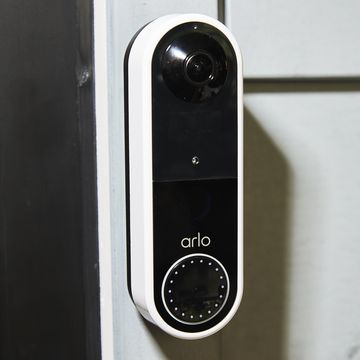
The Best Doorbell Cameras for Surveillance

The 4 Best Smart Bird Feeders for Your Backyard

Amazon Warehouse Milwaukee Sale: Up to 42% Off
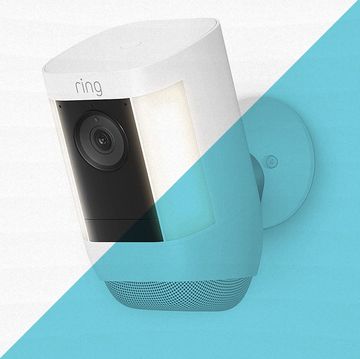
The Best Wireless Security Cameras for Your Home
Star Trek: How Does Holodeck Technology Work?
Exploring the ins and outs of this amazing science fiction creation.
In the wild and wonderful world(s) of Star Trek, one of the biggest core elements has to be the futuristic technology dreamed up by the creative writing team. While the majority of these seem unachievable, some of them have actually steered the creation of technology that people now use on a near-daily basis .
Of all the incredible things Star Trek has shown, none is potentially more alluring and incredible than that of the holodeck. This seemingly impossible creation acts as the cornerstone for many TNG plot lines. But how exactly is this tech supposed to work?
RELATED: Star Trek: Exploring The Borg’s Creepiest Weakness
While the holodeck is an incredible piece of technology, it is really more of a plot device than an actual fully functioning, and fictionally scientific creation. This is in contrast to something like the franchise's warp drive , which is totally fictional, but it has a solid grounding in fictional science. The warp drive can be explained (granted, using made up concepts, materials, and science). It makes sense within the universe. Holodecks, much like transporters , have never been fully explained, and often they conflict with other previously stated information provided with the audience. This is often the way with such a massive universe like Star Trek, which has had multitude of writers over the course of multiple decades.
The holodeck is, conceptually, a fairly simple bit of kit. It allows the users to fabricate any environment and situation their mind can dream up (or more accurately, that their hands can code). It is primarily a form of entertainment. While it can be used for training exercises to test real life situations and scenarios, its main purpose is to allow crew members to unwind and have fun. It can be used to create relaxing spas, Olympic stadiums to work out in, and most importantly for the writers, to dream up wacky situations for the protagonists to come up against. The heroes of the show have battled holodeck foes such as holographic Moriarty's and space Nazis. These are obviously less relaxing for the crew, often putting them in real peril. But as a foundation for an entertaining episode, the holodeck is the perfect bouncing board.
There are four primary cornerstones for how the holodeck works. The most important of these is the hologram itself. Throughout the years, Star Trek has had fun playing around with the idea of holographic lifeforms , and whether they can gain sentience or actually be ‘alive.’ But for the fundamentals of the holodeck, these holograms are much more simplistic. Unless tampered with, they are usually lacking in the sentience department. They are 3-dimensional images controlled by the holodeck computer, wrapped in a type of force field that simulates the feeling of physicality. The EHD (Emergency Holographic Doctor) from Voyager, while a much more complex hologram, works on the same fundamentals. He can deactivate his force field to allow objects and others to pass straight through him. Holograms are not inherently physical; they are more like a highly intricate assortment of light.
The second important element of a holodeck is the AI. This is the computer intelligence ( much more advanced than ones found today ) that creates the holodeck simulations. While more complex simulations require a person to write out the code and script, most of the time, the computer is able to create stories, situations, environments, all from the simple verbal commands of its user. It can take these commands and create an entire program based upon often vague suggestions. There is also primitive (at least, primitive for the minds of the future) AI found within the holograms, giving them their character and allowing them to react naturally to whatever the holodeck does. This is where things often get dicey, with the AI becoming self-aware under specific circumstances.
The built-in replicator is also an important element of the holodeck. Most of the objects found within the simulation are just holograms (like furniture and tools). However, some are actually physical, real things. Food and drink is a prime example of this. Users can eat using holographic plates, knives and forks, on a dining table made from light, but actually consume real, nutritious, and tasty food. It’s the same technology used for the replicators elsewhere on the ship, able to create any non-living object .
Finally, the holodeck also uses a combination of treadmills (though that name makes them sound far more rudimentary than they are) and blended light to give the illusion of distance. The holodeck itself is fairly small. While distance can be fabricated easily using holograms, actually walking off into the sunset for miles and miles is only possible using the treadmills built into the floor of the space. The user would largely remain in the center of the room, with the holographic simulations moving around them. If there is more than one person using the holodeck at once, then, upon spreading out, they are sectioned into their own, smaller holographic space.
While these are fundamentals of how the holodeck works, It's impossible to go into any real depth into the fiction technology, and exploring how exactly the computer is able to create the simulations. If it were, maybe holographic technology might be something possible today. But as it stands, the writers have never been able to flesh it out properly. Perhaps as more and more Star Trek programs are added to the franchise, and the universe continues to be fleshed out by programs such as Discovery, Picard and Strange New Worlds the technology will finally be given a proper scientific grounding. But until then, it remains one of the best, and most desirable, examples of science fiction ‘magic’.
MORE: Star Trek: How This Deep Space 9 Episode Changed The Franchise Forever
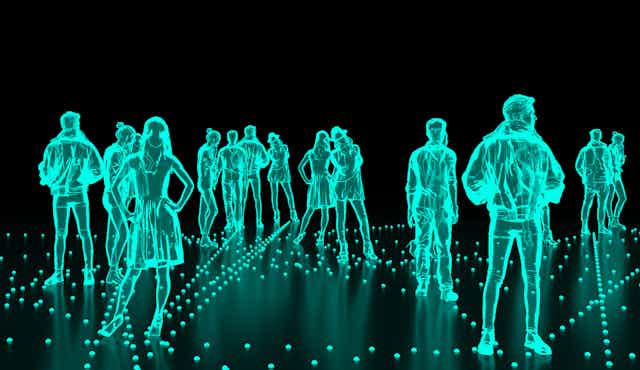
We created holograms you can touch – you could soon shake a virtual colleague’s hand
Professor of Electronics and Nanoengineering, University of Glasgow
Disclosure statement
Ravinder Dahiya receives funding from Engineering and Physical Science Research Council (EP/R029644/1 and EP/R511705/1).
University of Glasgow provides funding as a member of The Conversation UK.
View all partners
The TV show Star Trek: The Next Generation introduced millions of people to the idea of a holodeck: an immersive, realistic 3D holographic projection of a complete environment that you could interact with and even touch.
In the 21st century, holograms are already being used in a variety of ways such as medical systems, education, art, security and defence. Scientists are still developing ways to use lasers, modern digital processors, and motion-sensing technologies to create several different types of holograms which could change the way we interact.
My colleagues and I working in the University of Glasgow’s bendable electronics and sensing technologies research group have now developed a system of holograms of people using “aerohaptics”, creating feelings of touch with jets of air. Those jets of air deliver a sensation of touch on people’s fingers, hands and wrists.
In time, this could be developed to allow you to meet a virtual avatar of a colleague on the other side of the world and really feel their handshake. It could even be the first steps towards building something like a holodeck.
To create this feeling of touch we use affordable, commercially available parts to pair computer-generated graphics with carefully directed and controlled jets of air.
Read more: Five surprising ways holograms are revolutionising the world
In some ways, it’s a step beyond the current generation of virtual reality, which usually requires a headset to deliver 3D graphics and smart gloves or handheld controllers to provide haptic feedback, a stimulation that feels like touch. Most of the wearable gadgets-based approaches are limited to controlling the virtual object that is being displayed.
Controlling a virtual object doesn’t give the feeling that you would experience when two people touch. The addition of an artificial touch sensation can deliver the additional dimension without having to wear gloves to feel objects, and so feels much more natural.
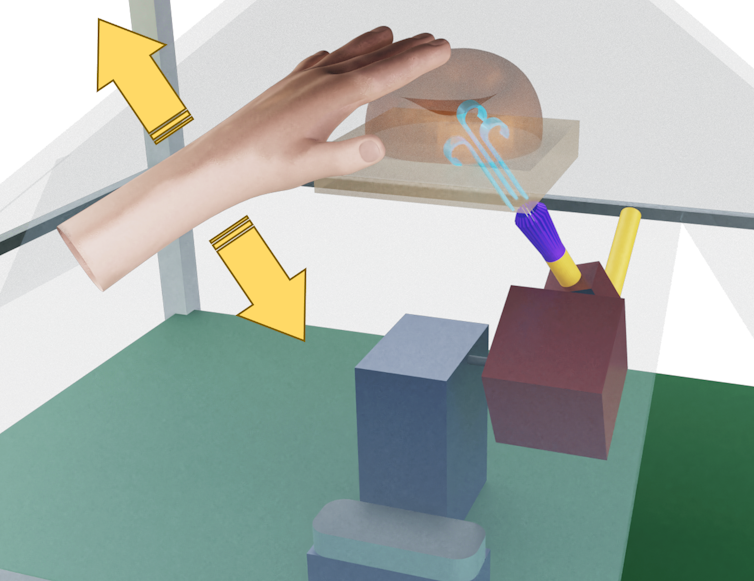
Using glass and mirrors
Our research uses graphics that provide the illusion of a 3D virtual image. It’s a modern variation on a 19th-century illusion technique known as Pepper’s Ghost , which thrilled Victorian theatregoers with visions of the supernatural onstage.
The systems uses glass and mirrors to make a two-dimensional image appear to hover in space without the need for any additional equipment. And our haptic feedback is created with nothing but air.
The mirrors making up our system are arranged in a pyramid shape with one open side. Users put their hands through the open side and interact with computer-generated objects which appear to be floating in free space inside the pyramid. The objects are graphics created and controlled by a software programme called Unity Game Engine, which is often used to create 3D objects and worlds in videogames.
Located just below the pyramid is a sensor that tracks the movements of users’ hands and fingers, and a single air nozzle, which directs jets of air towards them to create complex sensations of touch. The overall system is directed by electronic hardware programmed to control nozzle movements. We developed an algorithm which allowed the air nozzle to respond to the movements of users’ hands with appropriate combinations of direction and force.
One of the ways we’ve demonstrated the capabilities of the “aerohaptic” system is with an interactive projection of a basketball, which can be convincingly touched, rolled and bounced. The touch feedback from air jets from the system is also modulated based on the virtual surface of the basketball, allowing users to feel the rounded shape of the ball as it rolls from their fingertips when they bounce it and the slap in their palm when it returns.
Users can even push the virtual ball with varying force and sense the resulting difference in how a hard bounce or a soft bounce feels in their palm. Even something as apparently simple as bouncing a basketball required us to work hard to model the physics of the action and how we could replicate that familiar sensation with jets of air.
Smells of the future
While we don’t expect to be delivering a full Star Trek holodeck experience in the near future, we’re already boldly going in new directions to add additional functions to the system. Soon, we expect to be able to modify the temperature of the airflow to allow users to feel hot or cold surfaces. We’re also exploring the possibility of adding scents to the airflow, deepening the illusion of virtual objects by allowing users to smell as well as touch them.
As the system expands and develops, we expect that it may find uses in a wide range of sectors. Delivering more absorbing video game experiences without having to wear cumbersome equipment is an obvious one, but it could also allow more convincing teleconferencing too. You could even take turns to add components to a virtual circuit board as you collaborate on a project.
It could also help clinicians to collaborate on treatments for patients , and make patients feel more involved and informed in the process. Doctors could view, feel and discuss the features of tumour cells, and show patients plans for a medical procedure.
- Electronics
- Virtual reality
- Interdisciplinary research
- Interdisciplinarity
- Interdisciplinary thinking

Events and Communications Coordinator

Assistant Editor - 1 year cadetship

Executive Dean, Faculty of Health

Lecturer/Senior Lecturer, Earth System Science (School of Science)

Sydney Horizon Educators (Identified)

Make 3D Scenes With A Holodeck-Like Voice Interface
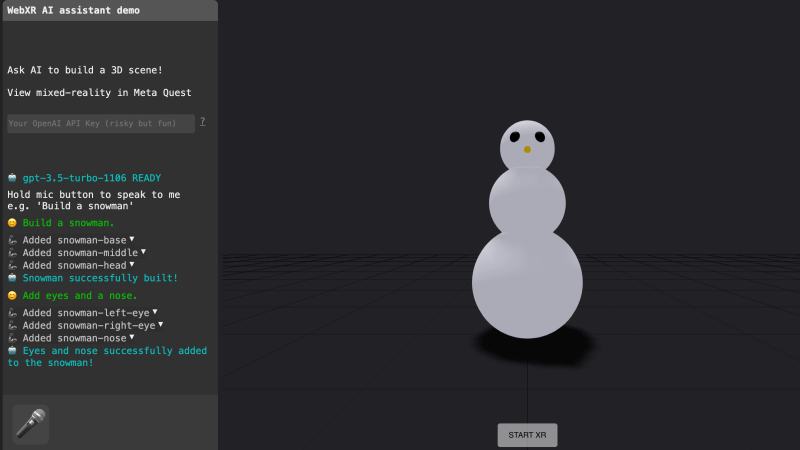
The voice interface for the holodeck in Star Trek had users create objects by saying things like “create a table” and “now make it a metal table” and so forth, all with immediate feedback. This kind of interface may have been pure fantasy at the time of airing, but with the advent of AI and LLMs (large language models) this kind of natural language interface is coming together almost by itself.
The catch is that since the program uses OpenAI APIs on the back end, one must provide a working OpenAI API key. Otherwise, the demo won’t be able to do anything. Providing one’s API key to someone’s web page isn’t terribly good security practice, but there’s also the option of running the demo locally.
Either way, once the demo is up and running the user simply tells the system what to create. Just keep it simple. It’s a fun and educational demo more than anything and will try to do its work with primitive shapes like spheres, cubes, and cylinders. “Build a snowman” is suggested as a good starting point.
Intrigued by what you see and getting ideas of your own? WebXR can be a great way to give those ideas some life and looking at how someone else did something similar is a fine way to begin. Check out another of [Dominic]’s WebXR projects: a simulated BBC Micro, in VR .

4 thoughts on “ Make 3D Scenes With A Holodeck-Like Voice Interface ”
I am thoroughly impressed Now all that remains in my life is to buy a computer which can do this, and an AI TTS engine hooked up to an LLM locally and then become a hermit
Fun fact, classical computers actually hit quantum speeds 4 years ago, and humans have just been too distracted to notice 🙃
The Holodeck. Man’s last invention.
Man’s second last invention, the last being the automatic Holodeck Biofilter cleaner.
Leave a Reply Cancel reply
Please be kind and respectful to help make the comments section excellent. ( Comment Policy )
This site uses Akismet to reduce spam. Learn how your comment data is processed .
Never miss a hack
If you missed it.

The Great Green Wall: Africa’s Ambitious Attempt To Fight Desertification

Your Open-Source Client Options In The Non-Mastodon Fediverse

Supercon 2023: MakeItHackin Automates The Tindie Workflow

NASA Is Now Tasked With Developing A Lunar Time Standard, Relativity Or Not
Our columns.

FLOSS Weekly Episode 782: Nitric — In Search Of The Right Knob

Displays We Love Hacking: LVDS And EDP

The 2024 Business Card Challenge Starts Now

Retrotechtacular: How Not To Use Hand Tools

Retrogadgets: The Ageia PhysX Card
By using our website and services, you expressly agree to the placement of our performance, functionality and advertising cookies. Learn more
Screen Rant
Star trek: first contact - 10 things that make no sense.

Your changes have been saved
Email Is sent
Please verify your email address.
You’ve reached your account maximum for followed topics.
Jason Statham's $152M Action Thriller Is A Streaming Success After Becoming 2024’s First Box Office Hit
How did this 27-year-old thriller get declared the best movie ever by rotten tomatoes, the fall guy's box office confirms a harsh reality after $2.4 billion phenomenon.
When Jonathan Frakes stepped into the director's chair to helm the second big-screen film starring the Star Trek: The Next Generation crew, he knocked it clear out of the park. Not only was it one of the most popular and recognizable of the Hollywood Star Trek films, but it was also one of the most action-packed and entertaining, as well.
RELATED: 10 Times Star Trek Villains Were Right
However, as good as Frakes is behind the camera, he fell victim to a script with more than a few holes and problems. The following is a breakdown of all the things about Star Trek: First Contact that don't make a lick of sense. While it doesn't harm the overall film to any major degree, it's hard to re-watch it without spotting these glaring issues from orbit.
Starfleet Tells Picard To Sit It Out
The first and most obvious nonsensical plot hole occurs directly at the beginning of First Contact , when Picard learns that he won't be participating in the battle against the near-invincible Borg , due to concerns about his ability to handle it. Instead, Starfleet transfers this "unstable element" out of the equation and orders him to patrol the neutral zone in case the dastardly Romulans take advantage of the situation.
Obviously, this makes no sense. A Borg invasion of Earth would mean the annihilation of the Federation, at which point it wouldn't matter. Also, the Enterprise-E is considered the Federation flagship. Every single vessel would count in such a fight, not to mention the combined experience of the crew members who single-handedly defeated the Borg the first time around.
Picard's Telepathic Connection
It isn't known why Picard is able to "hear" the Borg in his mind, despite the removal of his implants and nanotech devices during his time as Locutus. It seems less like a plausible theory, and more like a convenient plot device designed to give the Enterprise an excuse to blow up the cube, and get the Borg on board their ship for the big showdown.
Former Borg have been able to communicate indirectly with the collective after being separated, most notably Seven of Nine. However, she still had Borg implants in her body that could not be removed, including a subspace transceiver. No good explanation is given for Picard's ability.
Why Don't The Borg Use Time Travel All The Time?
One of the most head-scratching plot holes in the film occurs directly in the first act when a vulnerable Borg Cube spits out an escape Sphere, which immediately tunnels backward through time and assimilates Earth in the past. The Enterprise rides the temporal wake and follows it back in order to repair the damage.
The question here, is obvious - why don't the Borg use this tactic all the time, and why haven't they tried it again? If it were so easy to tunnel backward through time, why not send a single Borg Cube back to an earlier time period in the Delta Quadrant and make the journey to Earth, or multiply the Collective's existing knowledge to give them an even stronger advantage? As usual, time travel in sci-fi stories tends to raise more questions than answers .
Why Didn't The Enterprise Detect The Borg?
After the Borg Sphere is destroyed, some of the remaining Borg manage to transport onto the Enterprise, unbeknownst to the crew. They then proceed to assimilate the Enterprise from the inside out, spreading like a terrifying virus throughout the ship and taking over the crew. How they managed to get that far, is anyone's guess.
RELATED: Star Trek: 10 Relationships That Fans Knew Were Doomed From The Start
Surely the vastly upgraded Enterprise-E's advanced sensor package would detect an unauthorized boarding party? A partial explanation is given when Picard and crew member Hawk discuss the downing of internal sensors before they beamed aboard, but that very same conversation implies the sensors are back up, which begs the same question.
Where Does Zefram Cochrane Get His Funding?
By the time the Borg and the Enterprise make it back to a past Earth, the planet is in tatters. World War III just took place, destroying most of the world's governments and plunging humanity into great darkness. Amidst all this, Zefram Cochrane decides to build a warp ship that will forever change the trajectory of the human race.
The question is, how? Building any sort of rocket-based ship is no easy feat. It requires hundreds of people and countless work hours to achieve. The fact that Cochrane was building humanity's first warp-enabled vessel makes it even more daunting. Who exactly was funding this little operation? It's very possible that he simply stole all the materials he needed since nobody was around to stop him, but that's some mighty high-grade hardware. That seems to contradict his words in the final act of the film, when he discusses his motivations for building the Phoenix - "Dollar signs. Money!" Perhaps that was his intention before the third World War broke out, but the maintenance costs alone would have bankrupted him.
Why Do The Borg Require A Queen?
It could be argued that the introduction of the Borg Queen was both the best, and worst thing to happen to the Borg. On the one hand, it added a bit of a refresh onto a villain that was quickly becoming stale. On the other hand, it robbed the Borg of their menace and creep factor by adding in a relatable antagonist for audiences to focus on.
Whatever one's belief, why would the Borg require a Queen at all? Yes, they operate in a Hive mind, but that same Hive mentality should have been all that was required to get a job done. Arguments in favor of the Queen largely center around her rhetoric about bringing "order to chaos" within a particular system, which does not explain the need for Picard to have been turned into Locutus. It is implied in the film that the Borg Queen was on the first Cube that abducted Picard. Surely, such an emotive being could have done the job better than Locutus when it came to speaking for the Borg? A counterpart would have been redundant.
Why Try To Blend In On The Holodeck?
A particularly cool scene in the film takes place in the middle act when Picard and his reluctant ward Lily hideout in the Holodeck to evade pursuing Borg drones. The idea is to kill them so Picard can access their memory banks and determine their overall objective. Picard fires up one of his famous Dixon Hill simulations and invites Lily to join him so they can blend in with the surroundings.
This makes absolutely no sense since the Borg would no doubt be able to tell hologram-based characters from humans, without the use of special scanning software. It also doesn't contribute to Picard's overall plan in any meaningful way. He could have simply turned off the safety protocols and picked up a holographic gun at the very start and mowed down his Borg pursuers without a program running in the background.
Why Does The Borg Queen Have Emotions?
Speaking of emotions, it still hasn't been explained why the Borg Queen is so emotive, in the first place. The Borg are a logical Hive mind comprised of structure, repetition, and single-mindedness that lacks anything resembling feelings. Yet, the Queen is capable of everything from compassion, to anger, rage, and sly manipulation.
Emotions would have undoubtedly wreaked havoc within such a collective Hive mind and put all Borg in jeopardy. There would be no room for such an unpredictable set of equations within the Borg's system of governance, especially if she was capable of flying off the handle whenever things got too rough.
How Did Cochrane Land The Warp Ship?
One of the coolest parts of First Contact is the ability to see humanity's first warp-enabled vessel make its legendary test flight. Without this flight, Star Trek would have never seen the light of day. The quirky way the writing team went about this fabled launch is funny, entertaining, and upbeat, but it's also confusing.
RELATED: 10 Classic 50s Sci-Fi Movies That Still Appeal To A Modern Audience
After the warp ship conducts its warp test and successfully attracts the attention of the Vulcans , how exactly did it come back down to Earth? This is a rocket design, as opposed to a shuttle, so how did it land? Certainly not on its nacelles, and definitely not on its afterburner, unless it stole a bit of reusable rocket tech from SpaceX.
How Did The Enterprise Get Back To Its Own Time So Easily?
Just as it seems implausible that Borg so casually slipped back through time to assimilate Earth, so too does it seem implausible that the Enterprise would have had as easy a go of it. According to the film, it's just a matter of simple calculations. A similarly implausible scenario has plagued Star Trek TV shows and movies before, particularly Star Trek IV: The Voyage Home .
The truth is that if it were so easy to spiral back into the past, everyone would try it. The temptation would be far too great. Any time scriptwriters make it too easy to move back and forth in time, they create one gigantic elephant that takes up the entire room. So it is with First Contact.
NEXT: 10 Space Movies That Are Not Sci-Fi (According To IMDb)

IMAGES
VIDEO
COMMENTS
However, what most fans don't know is that the original ending to the ep would have made the holodeck (already the most confusing Trek technology) even harder to understand. For any of this to make sense, we need to first review the basics. On Star Trek: The Next Generation, characters use the holodeck for next-level recreation. The computer ...
Warning: SPOILERS for Star Trek: Discovery Season 4, Episode 2 - "Anomaly".. Captain Michael Burnham (Sonequa Martin-Green) made a big holodeck change in Star Trek: Discovery season 4, episode 2 but now the physics of the holograms make even less sense than they used to. In Star Trek: Discovery season 4, Captain Burnham and her crew are facing their direst challenge: investigating a ...
Warning: contains spoilers for Star Trek Annual 2023! The "holodeck gone awry" cliché repeats across the Star Trek franchise, but now a new spin has made this idea fresh once again. Numerous episodes have centered around something going wrong while on the holodeck, to the point where fans became critical, calling out the overuse of the trope.
Aug 15, 2005. Nope, the holodeck makes no sense whatsoever and cannot be rationally justified as a believable idea in any way. I'm surprised no one in this thread has mentioned the minuscule prison-cell-like space that an entire 'holodeck' is supposed to allegedly occupy. That is IMO the most absurd thing of all.
Star Trek: 10 Questions About The Holodeck, Answered. In the ongoing debate between fans of Star Trek and Star Wars over which sci-fi giant is the superior franchise, a huge point in Star Trek 's favor is the consistency of its fictitious science and technology. While Star Wars throws its audience curveballs like midichlorians and the Holdo ...
That makes sense. But it would make even more sense if the entire experience is projected directly into the brain as others have said. The biggest problem with the holodeck is the amount of physical people in there. The biggest offender in this regard was Vick's on DS9 but Sandrine's on Voyager was pretty bad too.
The Holodeck first appeared in The Practical Joker, a 1974 episode of the Star Trek animated series. It was depicted as a recreation room containing a simulated, alternative version of reality. It ...
Since the moment we first saw Commander William T. Riker step out of an air-conditioned corridor on the U.S.S. Enterprise-D and into a lush green forest — still aboard the Enterprise — in "Encounter at Farpoint," the holodeck has become a Starfleet fixture and a signature innovation of the Star Trek universe.. An early incarnation of the holodeck first appeared in an episode of Star ...
11 THE BIG GOODBYE, TNG. This was one of the first major holodeck episodes and (amazingly) is the only TNG episode to win a Peabody Award. To the surprise of the crew, the cultured Captain Picard loves to play Dixon Hill, a rough and tumble 1940s private eye.
You forget that in the star trek world, the environment isn't polluted, you get paid a very comfortable living wage, education is phenomenal, access to healthcare is also phenomenal. Life is significantly better in this time, so the holodeck really is just like a GameCube to them, nothing more.
It makes sense that a starship would have the ability to replicate a 12 gauge shotgun -- theoretically you might need it on some planet. So when a 12 gauge appears in a holodeck program, the computer just grabs the file from the replicators and produces a "holomatter" (or whatever) version.
What makes the show creators' holodeck idea even more remarkable, is that there's a very realistic explanation behind holodecks: its science is explained in the Voyager Technical Manual. The technology is based on two concepts: 1) holographic imagery with force fields to project illusions for the human participant, and 2) replicator ...
The sheer programming complexity required for the holodeck to work as depicted on Star Trek is so fun to think about. The more you dig into it, the more and more complex the computational work that would have to be done. ... There's a grand amount of things that don't make sense about the holodeck, but this is a big one. I've read the ...
Beginning with Star Trek: The Next Generation season 1, episode 12, "The Big Goodbye," holodeck episodes became a staple of many Trek series. "The Big Goodbye" was one of the best episodes of TNG ...
The Star Trek: Prodigy executive producer explains that the holodeck in Lower Decks manipulates perspective in complex ways that exceed our current understanding. Wide shots with characters in different locations have been seen before in the Star Trek universe. Star Trek: Lower Decks and Star Trek: Prodigy's holodecks have also evolved ...
The Holodeck title apparently isn't just a nickname among the actors; according to Variety, posters of the holodeck from "Star Trek: The Next Generation" adorn the walls along the path to the ...
In an episode of first season of Voyager "The Cloud", they mentioned something that made no sense, that the power supply from the Holodeck is incompatible with the rest of the ship. Keep in mind that it probably just didn't work for that week's episode, because that's what the script needed to have happen. This happens all the time in Star Trek.
For that, Star Trek's holodeck actually manipulated matter into the necessary shape so people could feel and interact with objects on the holodeck. Nifty stuff, but no one is working on it in real ...
We all want Star Trek's holodeck. And we're all going to keep waiting for that, because frankly, most of what makes the Star Trek holodeck awesome is probably impossible. ... Real, in a sense ...
This is often the way with such a massive universe like Star Trek, which has had multitude of writers over the course of multiple decades. The holodeck is, conceptually, a fairly simple bit of kit ...
The realism of the holodeck in Star Trek has made television shows, movies, and video games largely obsolete by the 24th century, although some characters still like the nostalgia of old-school media. Captain Jean-Luc Picard (Patrick Stewart) regularly reads physical books even though holo-novels exist, and the entire crew of the USS Enterprise ...
The TV show Star Trek: The Next Generation introduced millions of people to the idea of a holodeck: an immersive, realistic 3D holographic projection of a complete environment that you could ...
The voice interface for the holodeck in Star Trek had users create objects by saying things like "create a table" and "now make it a metal table" and so forth, all with immediate feedback ...
Star Trek: The Next Generation is the gold standard in '80s/'90s TV science fiction. It proved that the original Star Trek wasn't a fluke, and that it could age like fine wine, tackling difficult subjects in the best tradition of its predecessor.. However, even the biggest fans of TNG know that there are aspects of the show that don't compute, and make absolutely no sense to anyone who's ...
Published Mar 8, 2021. First Contact is one of the most action-packed and entertaining Star Trek movies. But that doesn't mean it's free of flaws and senseless aspects. When Jonathan Frakes stepped into the director's chair to helm the second big-screen film starring the Star Trek: The Next Generation crew, he knocked it clear out of the park.